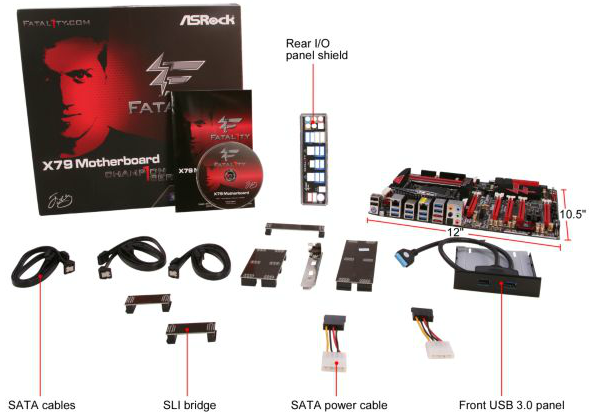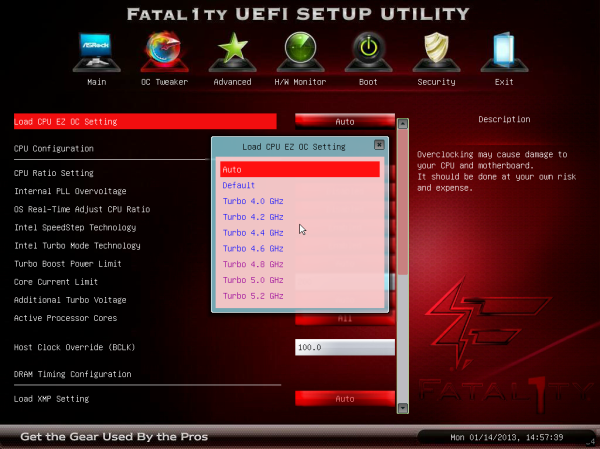ASRock Fatal1ty X79 Champion and X79 Professional Review: From a Gamer to Gamers
by Ian Cutress on February 9, 2013 10:30 AM EST- Posted in
- Motherboards
- ASRock
- Fatal1ty
- X79
ASRock X79 Champion In The Box
With these high-priced system configurations, it is sometimes hard to predict what extras come with the package. Every motherboard manufacturer should be trying to give something special with their motherboard – either in terms of something we would actually use (WiFi/USB 3.0 combination box), a little gimmick that becomes part of a daily routine (a keychain or belt buckle), or some memorabilia (cloth bag with logo for carrying accessories, poster or a ‘do not disturb’ door sign). This is not always the case – if a product is stripped down to be as cheap as possible but still have high end features, we may not take away more than a couple of SATA cables. A $1.50 keychain in every box might mean an extra $5 on the box cost, resulting in pricing the motherboard out of the market. The only SKU that gets free reign are the ultimate high end models (Z77X-UP7, Rampage IV Extreme, X79 Extreme11), but seeing as the Champion is the high end X79 gaming model from ASRock, should we be expecting anything special, such as a Fatal1ty branded lanyard or stickers?
In the X79 Champion, we get the following:
Driver CD
User Manual
Rear IO Shield
Six SATA Cables
Two Molex to SATA Power Cables
Two 2-slot Rigid SLI Bridges
One 3-slot Rigid SLI Bridge
One 2-slot Rigid 3-way SLI Bridge
One 3-slot Rigid 3-way SLI Bridge
USB 3.0 Front Panel with Rear Bracket included

There is nothing Fatal1ty branded (not even the SLI bridges or USB 3.0 front panel), but a wide selection of everything in a standard motherboard package. Six out of ten SATA cables is a reasonable number, but I wonder how many users will be needing molex to SATA power cables when they are spending $300+ on a motherboard and possibly $550+ on a CPU? Actually what I am more concerned about is the number of SLI bridges included. A total of five across four sizes for any NVIDIA combination scenario is a bit silly, and probably adds $10+ to the overall cost of the motherboard. AMD got it right with a standard connector and insisting all of its partners include one in the box of every card (not that all of them do), rather than putting the emphasis on the motherboard manufacturers. In retrospect, by doing it this way, NVIDIA sells more SLI bridges. This motherboard package only needs two – a 4-way SLI bridge for PCIe 1/2/4/5, and a 3-way SLI bridge for 1/3/5.
ASRock X79 Champion Overclocking
Experience with ASRock X79 Champion
Recent overclocking attempts with ASRock boards have been overtly successful when isolated purely by the BIOS. The amount of automatic overclocking options has been plentiful, and the layout of the BIOS makes it amenable to adjusting voltages, VDroop and clock speeds. The downside is often the overclock options in the operating system, which are varied in their usefulness such that there are no automatic options, and manual options are enabled only after booting into the OS and when a program is running.
Unfortunately we also have another issue – the 3960X we have used in our overclocking tests since November 2011 is not running at its best. After using it for several small extreme overclocking sessions (5.2+ GHz), it now requires more voltage to get to similar clocks at the beginning of its life (e.g. 1.45V for 4.6 GHz now rather than 1.40 V). In the grand scheme of things this is not too bad – if this 3960X was a poor sample to begin with, it would have showed these traits. This just means that the OC results for this review should not be directly compared to other X79 reviews, as we hit the ambient temperature cooling limitations quicker such that the system automatically reduces clock speeds.
Overall the overclocking experience through the BIOS was easy. Keeping track of what the automatic OC options did helped shape how the manual overclocking went, especially in terms of load line calibration and power limits. At the high voltages and speeds, the temperatures caused the system to automatically reduce the multiplier rather than overheat, suggesting that a fine tune is needed for the optimum speed.
Methodology:
Our standard overclocking methodology is as follows. We select the automatic overclock options and test for stability with PovRay and OCCT to simulate high-end workloads. These stability tests aim to catch any immediate causes for memory or CPU errors.
For manual overclocks, based on the information gathered from previous testing, starts off at a nominal voltage and CPU multiplier, and the multiplier is increased until the stability tests are failed. The CPU voltage is increased gradually until the stability tests are passed, and the process repeated until the motherboard reduces the multiplier automatically (due to safety protocol) or the CPU temperature reaches a stupidly high level (100ºC+).
Our test bed is not in a case, which should push overclocks higher with fresher (cooler) air. We also are using Corsair’s H80i with a push-pull fan arrangement. This is a 120mm double-width radiator liquid cooler, designed to mimic a medium-to-high end air cooler.
Automatic Overclock:
The X79 Champion offers seven automatic overclocking options in the BIOS under the CPU EZ OC Menu:
Each of these options was stress tested under our normal setup conditions, with the following results:
As we moved through the options, the system increased the power and current limits on the board, along with applying a first a CPU voltage offset, then a fixed voltage value. The LLC was also adjusted from Level 5 (low) up to Level 1 (constant). Unfortunately the results were not that great, with the CPU and system maxing out at 4.4 GHz under these settings.
Manual Overclock:
From the automatic overclocking, the system was set to a power limit of 500W, a current limit of 300A, PLL Overvoltage turned on, and the LLC set to Level 1. In line with previous X79 reviews, we set the CPU to the 42x multiplier for 4.2 GHz, and the BIOS voltage at 1.350 volts. When the system passed the stress test, the multiplier was increased – if it failed, the voltage was increased. Repeat until cooked.
Our system managed to pass the stress tests at 4.7 GHz with an alarmingly high 1.525 volts set in the BIOS. At 4.8 GHz the system passed both tests, although when closing PovRay the system BSODed. At that temperature, the system was already starting to throttle the CPU multiplier, as shown by the irregular increase in the PovRay score. With these results, 4.5 GHz seems a happy spot to be in.













71 Comments
View All Comments
CeriseCogburn - Wednesday, February 13, 2013 - link
That ignorant "principle" called being a dumb*** cheapskate with an excuse will leave you in the dust half the time, but so what you probably LOVE amd like a fanboy fool like most here.LOL - Yes all the whining fools here are freaking fanboys anyway.
So since you have no clue who the guy is, wether or not you respect him is of no consequence, it's not even an opinion.
Problem is, you'd likely respect him if you had a clue.
Go watch some of the hour long vids - he certainly can earn your respect, I suspect it would happen.
Now back to your crybaby drone whining.
BTW - you an amd fanboy ? I bet you are. There's some more branding...
Concillian - Saturday, February 9, 2013 - link
"I don't get why they release these, he's done nothing in half a decade and no self respecting person who knows anything about hardware would buy because of a so called Celeb name being put on it. It just acts as a warning sign for me..."Well, it works in other markets... how about Michael Jordan endorsed products? He hasn't done anything of note recently... How many other retired competitors endorse products. Carl Lewis and Greg Louganis, long since retired, endorsed products well after retirement. Phelps surely will for years to come.
If they want to pay the guy to be able to use his name...more power to them and good for him. I'm not paying the bill or buying the products, so why would I care enough to speak out against it?
just4U - Sunday, February 10, 2013 - link
Look at the specs, the visuals.. than decide. the name is pretty much like any other. Asus has their line, Gigabyte.. MSI.. They all brand in one form or another to mark their high end. This is just another one is all.Blibbax - Sunday, February 10, 2013 - link
Asus aren't paying anyone to use the "RoG" brand.Blibbax - Sunday, February 10, 2013 - link
Though actually, I'd rather see the end of all those ridiculous brand names - "RoG", "Big Bang", "Classified", "Sniper" - none of them make any sense, and they all significantly cheapen the products they are attached to. The boards people really want are Asus Pro, Gigabyte UD9, Asrock Extreme11, and I think the lack of these stupid gamer brands is a lot of why.lukarak - Monday, February 11, 2013 - link
Sure they are. They are paying to market the RoG brand, thus increasing the price of the motherboards and other things. For example sponsoring tournaments. It's every bit the same as paying Wendel an amount for each product sold, if that's the licensing method they agreed upon.CharonPDX - Monday, February 11, 2013 - link
There's a reason he has changed manufacturers every couple years - and I doubt it's because each new one is offering him MORE money.......CeriseCogburn - Wednesday, February 13, 2013 - link
Yet the prior review Ian did with an Asrock motherboard had some overclocker bios with some guru branding and that board and bios was freaking awesome.So being a completely clueless idiot with a one size fits all mindset makes you a droning sheep like the rest of em here.
Congratulations on being just as dumb (dumber really, as age an experience claimed leaves you permanently clueless) as an emotionally excited teenybopper who loves Fatal1ty.
tynopik - Saturday, February 9, 2013 - link
"equipped with single screen a single GPU"Beenthere - Saturday, February 9, 2013 - link
John "Fatality" is a joke and Asrock is just milking what little success John Boy had in the past.The ignorant plastering of "Fatality" all over the mobo, heatsinks, OMs, etc. and on the BIOS and boot screen is for the 13 year old, immature, PC illiterate fanbois. Unfortunately the 13 year old kids don't represent the majority of the PC enthusiasts market so this marketing ploy to dupe the dumb, has pretty much failed. In fact their has been considerable backlash about the in-you-face display of John Boy by many Asrock consumers - to the point that Asrock has removed his Fuhly Puss from the BIOS menus completely and thankfully allows people to disable Jon Boy's face on the boot screen.
As far as the actual mobos are concerned, they are decent high end units, but nothing exceptional. They are IME as good as Asus or Gigabyte high end mobos, no more and no less. They appear to be more reliable than Asus as is Gigabyte, IME. I would recommend the Asrock Fatality models to enthusiasts for the mobo quality/performance over Asus, but not for the stupid marketing hype over John Boy.